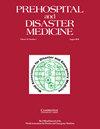Quantitative Metrics in Mass-Gathering Studies: A Comprehensive Systematic Review
IF 2.5
4区 医学
Q2 EMERGENCY MEDICINE
引用次数: 0
Abstract
Introduction: Mass gatherings are events where many people come together at a specific location for a specific purpose, such as concerts, sports events, or religious gatherings, within a certain period of time. In mass-gathering studies, many rates and ratios are used to assess the demand for medical resources. Understanding such metrics is crucial for effective planning and intervention efforts. Therefore, this systematic review aims to investigate the usage of rates and ratios reported in mass-gathering studies. Methods: In this systematic review, the PRISMA guidelines were followed. Articles published through December 2023 were searched on Web of Science, Scopus, Cochrane, and PubMed using the specified keywords. Subsequently, articles were screened based on titles, abstracts, and full texts to determine their eligibility for inclusion in the study. Finally, the articles that were related to the study’s aim were evaluated. Results: Out of 745 articles screened, 55 were deemed relevant for inclusion in the study. These included 45 original research articles, three special reports, three case presentations, two brief reports, one short paper, and one field report. A total of 15 metrics were identified, which were subsequently classified into three categories: assessment of population density, assessment of in-event health services, and assessment of out-of-event health services. Conclusion: The findings of this study revealed notable inconsistencies in the reporting of rates and ratios in mass-gathering studies. To address these inconsistencies and to standardize the information reported in mass-gathering studies, a Metrics and Essential Ratios for Gathering Events (MERGE) table was proposed. Future research should promote consistency in terminology and adopt standardized methods for presenting rates and ratios. This would not only enhance comparability but would also contribute to a more nuanced understanding of the dynamics associated with mass gatherings.大规模采集研究中的量化指标:全面系统回顾
导言:群众集会是指在一定时间内,许多人为了特定目的聚集在一个特定地点的活动,如音乐会、体育赛事或宗教集会。在群体聚集研究中,许多比率和比例被用来评估对医疗资源的需求。了解这些指标对于有效规划和干预工作至关重要。因此,本系统性综述旨在调查大规模聚集研究中报告的比率和比例的使用情况。方法:本系统性综述遵循 PRISMA 指南。使用指定的关键词在 Web of Science、Scopus、Cochrane 和 PubMed 上检索了截至 2023 年 12 月发表的文章。随后,根据标题、摘要和全文对文章进行筛选,以确定其是否符合纳入研究的条件。最后,对与研究目的相关的文章进行了评估。结果:在筛选出的 745 篇文章中,有 55 篇被认为与本研究相关。其中包括 45 篇原创研究文章、3 篇特别报告、3 篇案例介绍、2 篇简要报告、1 篇短文和 1 篇实地报告。共确定了 15 项衡量标准,随后将其分为三类:人口密度评估、会内医疗服务评估和会外医疗服务评估。结论本研究的结果表明,在大规模采集研究中,对比率和比例的报告存在明显的不一致。为了解决这些不一致的问题,并使大规模集会研究中报告的信息标准化,我们提出了 "集会活动的指标和基本比率(MERGE)表"。未来的研究应促进术语的一致性,并采用标准化的方法来列报比率和比例。这不仅可以提高可比性,还有助于更细致地了解与大规模集会有关的动态。
本文章由计算机程序翻译,如有差异,请以英文原文为准。
求助全文
约1分钟内获得全文
求助全文
来源期刊

Prehospital and Disaster Medicine
Medicine-Emergency Medicine
CiteScore
3.10
自引率
13.60%
发文量
279
期刊介绍:
Prehospital and Disaster Medicine (PDM) is an official publication of the World Association for Disaster and Emergency Medicine. Currently in its 25th volume, Prehospital and Disaster Medicine is one of the leading scientific journals focusing on prehospital and disaster health. It is the only peer-reviewed international journal in its field, published bi-monthly, providing a readable, usable worldwide source of research and analysis. PDM is currently distributed in more than 55 countries. Its readership includes physicians, professors, EMTs and paramedics, nurses, emergency managers, disaster planners, hospital administrators, sociologists, and psychologists.
 求助内容:
求助内容: 应助结果提醒方式:
应助结果提醒方式:


